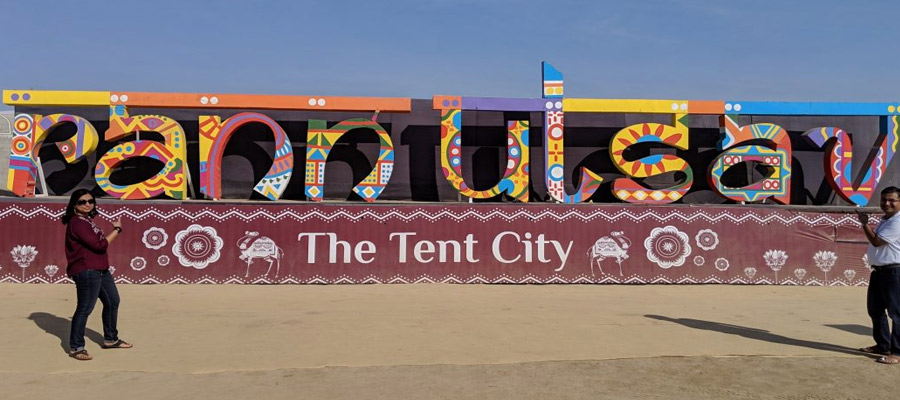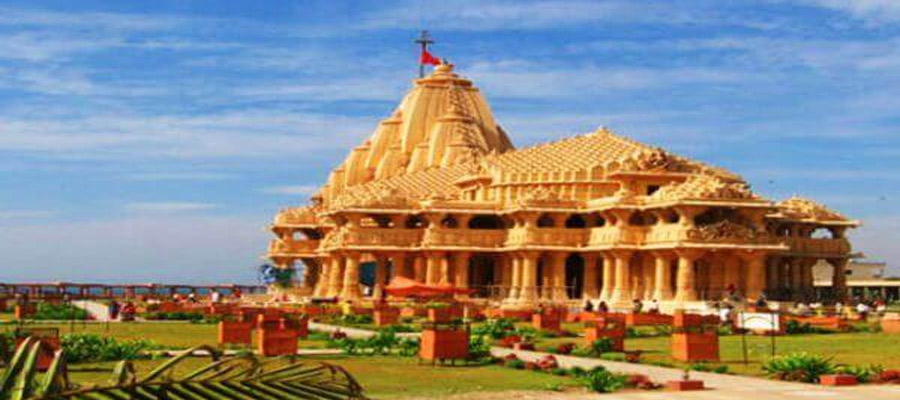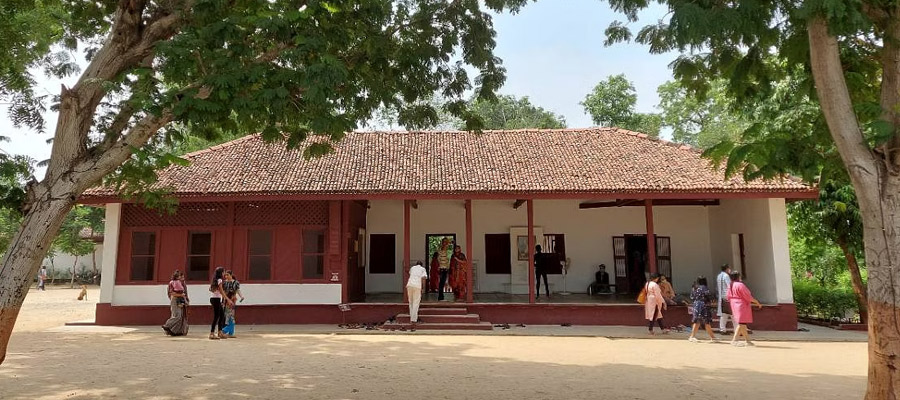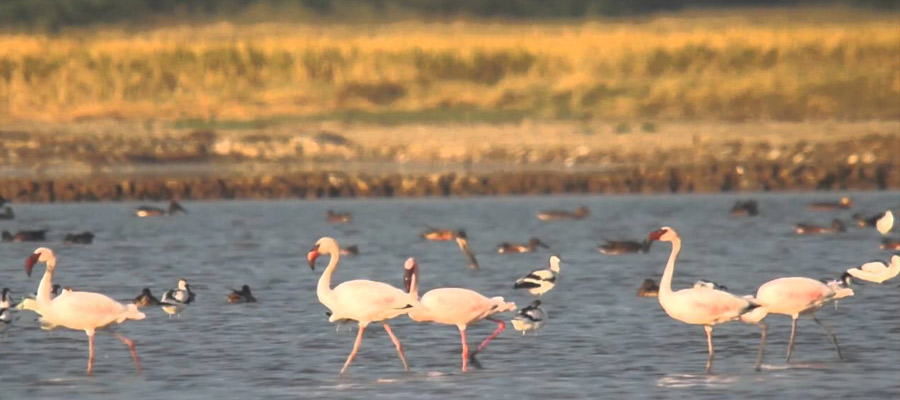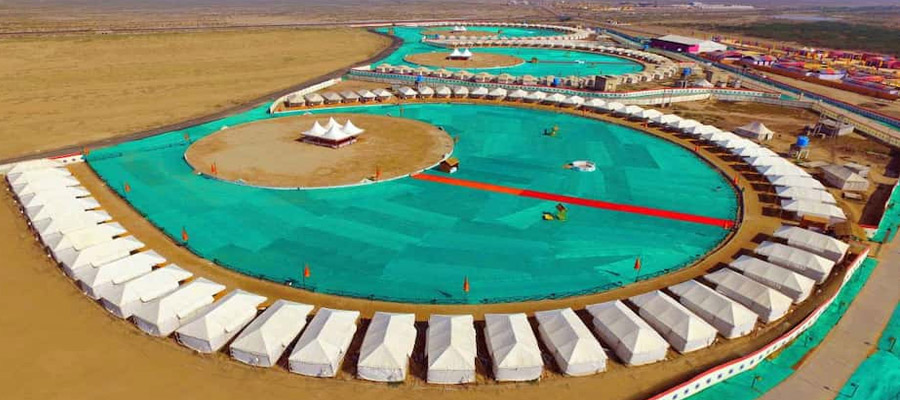Colors of Gujarat Tour
Day 01 / Ahmedabad
Pickup from Ahmedabad airport / railway station and drive to Ahmedabad hotel. After check in visit The Swetambara Temple Hatheesing temple was built outside Delhi gate in 1850 by a rich Jain merchant Sheth Hatheesing. This is the best known of Ahmadabad’s many ornate Jain temples. It is dedicated to Dharamnath, the fifteenth Tirthankar whose status stand in the main sanctuary Built by pure marble profusely decorated with rich carving.
Gandhi Ashram The beautiful ashram complex of Ahmadabad, with shady trees populated by thousand of parakeets, Beaters, sunbirds, squirrels, offers a refuge from the loud streets of the city and is one of the foremost tourist attraction of Ahmadabad. This ashram was Gandhi’s head quarters during the long struggle for Indian independence. His ashram was founded in 1915 and still makes handicrafts, handmade paper and spinning wheels. This ashram is open from 8.30 AM to 6.30 PM.
Adalaj, visit step well is an architectural wonder built by Queen Rudabai and is certainly one of the finest monuments of Gujarat. It is a seven-storied structure in the form of a well with chambers one behind the other. The ‘Vav’ or stepped wells of Gujarat were used as meeting and resting-places during summer since their cool interiors offered unbelievable respite from the scorching sun outside. O/n stay at Ahmedabad.
Day 02 / Ahmedabad – Patan – Modhera – Little Rann of Kutch (LRK)
Morning after breakfast proceeds to Patan, visit Patan Patola of weaving, patan is Famous for patola weaving, Salvi family is one of them who has continued this traditional art and has preserved it even today. Patola silk is often termed as the queen of all silk. The special technique of the handmade silk patola uses the same special technique for weaving from raw silk to the completion of the patola fabric. The weaver makes the special patola loom and colouring from indigenous natural materials. Patola from the area of patan in the north Gujarat region of western India glorifies this heritage with its unique gem like qualities, gorgeous colours, designing & durability Different colour and pattern matched exactly on horizontal and vertical threads in weaving. The patola was traditionally woven in a sari length of 5 to 9 yards by 45” to 54” width. The range now extends to include tablecloth borders scarves handkerchief.
Rani ki Vav (Step well). It was built by the Queen Udaymati the wife of Bhimdev during 11-12th Century. It is the most magnificent and spectacular step well and the best example of such architecture for water wells. The Vav measuring about 64 mts. The stepwell has long stepped corridor descending down to the underground tank, it is having four pillars. The Pillars which support the roof have squire base decorated with Ghat Pallavas. It was one of the largest and the most sumptuous structure of its type.
Later proceeds to Mohera visit Sun Temple at Modhera. The temple dates back to early 11th century and even in its ruined state, the Sun Temple is magnificent.
Continue drive to Bajana. O/n stay at Bajana.
Day 03 / Little Rann of Kutch
Enjoy morning safari at Little Rann Of Kutch viewing rarest wild asses in the region followed by village safari in the evening.
Wild ass sanctuary - The sanctuary is well known for its group of the stale joke brown Asiatic (Wild ass), which does not live elsewhere in Indian lowlands. We can see with Little Rann of Kutch blackbuck (Indian antelope), nilgai or blue bull (India’s largest antelope) and the graceful chinkara (Indian gazelle) are other mammals. The main carnivores of the Little Rann of Kutch are the endangered Indian wolf, desert fox, Indian fox, jackals, desert and jungle cats, and a few hyenas; also we can see during the visits flamingoes, pelicans, ducks, cranes and storks.
Village safari - We can do excursion safari tours of pastoral settlements and villages along the Rann of Kutch. The tours visit the rural Vadiara and Kharapat Rabaris of Dasada, known for their embroideries, the silk-weavers colony at Dasada, and Ambala village of the Bharward shepherds and goatherds. The weaving cooperative at Bajana and other artisans’ workshops can also be included in the tours. Other societies near Dasada are Padhars (primarily fishing people), the Siddis and the semi-nomadic Mirs, Jaths (Muslim herders), Bajanias. O/n stay at Bajana.
Day 04 / Little Rann of Kutch – Ajrakhpur – Bhuj
Morning after breakfast proceeds to Ajrakhpur to see the block printing by tribe, Dhaneti to observe the embroidery by the Ahir tribe and Bhujodi to view the weavers from the Vankar tribe. These block printing villages are home to the famousAjrakh craftsmen of the region. The latter is far from Bhuj and was largely destroyed by the earthquake, but there are still some great craftsmen and their workshops to visit there. In Ajrakhpur, not so far from KHAMIR, the famous Dr. Ismail Katri (for most of the practitioners are Katris), and his sons are friendly and make incredibly beautiful prints. But walking around and meeting the other craftmen is a must – there is great diversity in the craft.
Bhujaodi 10 km out off Bhuj, artisans weave thick shawls and blankets on pit looms dug into the of crouch mud houses (Bhungas)decorated with garomati. The ancient tradition of weaving shawls and blankets from coarse sheep hair came into existence generations ago essentially as a form of barter between the "rabari" community or the nomadic grazing community and the vankars (weavers) — "the rabaris brought us the sheep hair from which we made blankets and shawls for them after spinning the sheep hair into wool.
Continue drive to Bhuj. O/n stay at Bhuj.
Day 05 / Bhuj – Mata no Madh – Mandvi
Morning after breakfast proceeds to Mata na madh (Goddess of Kutch kingdom, Maa Ashapura’s magnificient Temple is located here.Three numbers of annual celebrations- called three “Navraatries” are celebrated here as a big festivals. Pilgrims from all over india and abroad visit this place during” Navraatries” Some pilgrims visit this place by foot for about 100 kms journey to this Temple. Other places of interest are chaachar Kund, Hinglaa-Maate temple, essence sticks of “Aashapuri” brand is very much famous of this place.
Later proceeds to Mandvi visit Mandvi, visit indispensable. But the town is also easily explored on foot, and it is well worth wandering the narrow streets to check out the mix of old architecture. Many wealthy barons during the city's heyday had flamboyant houses built, with lots of European influence; it is not uncommon to see carved angels, or stained-glass windows. The many bazaars, where all kinds of goods can be found, frombandhani textiles to tasty fresh produce, should not be missed. Specific points of interest are as follows, visit Vijay Vilas palace was built by Rao Vijayrajji, and is maintained in excellent condition today. The British Political Agent based in Bhuj had summer quarters at Mandvi, and the British cemetery attests to the extended presence of the British in the area.
Later visit 72 Jinalaya Jain Temple
This is an important holy place for the Jains which is almost 51 kms away from Bhuj. It has 72 Deris of Lord Mahavir. People always come to see this beautiful and attractive place. Bounter Jinalaya is also known as Adiswar Bounter Jinalaya Mahatirth.
Day 06 / Mandvi – Dhordo
Morning after breakfast proceeds to Dhordo, Enjoy Rann Utsav Desert Festival Kutch with crafts, music concert, folk dance, and lots of hastkala and handicrafts items over there.
Kutch Festival provides an exclusive opportunity to witness the creative initiative of the artisans and craftspeople. Nearly 32 cultural troupes from various districts of Gujarat participate in the Dance and Musical Carnival. The various locales within Kutch take one around the natural grandiose while introducing the visitor to the indigenous cultural and ethnical flavor of the people. Enjoy these cultural programmes performed in the midst of the White Salt Desert spread over miles. Overnight stay at Dhordo.
Day 07 / Dhordo
Morning after breakfast visit Banni Village enroute take permit (Please all client to need to obtain the permit). to see various people like Jat, Harijan, Meghawal and Mutva etc in various villages like Hodka, Ludiya and Dhordo. Banni means “a cluster of village”. In Banni area of Kutch the Meghwal-Harijans who migrated from Rajasthan use Khambira, Kharek, Kudi Stiches in their embroidery. Also outline and satin stitch embroidery of the area and very minute mirror designs similar to the famous Mutwa embroidery of the area. They make wall hangings, waistcoats and pouches in Kharek Stich and do 'Moti Bharat' or beadwork on handheld fans, bracelets, toys and belts. After visit HODKA village – Hodka derives from the Gujarati word ‘Hodi’which means ‘boat’. Since, thevillages here are called jheels, where potable water is available. Hodka is famous for its beautiful embroidery and mud work as much as Leather craft. Both men and women are actively involved in developing the art and craft tradition of the region. Visit LUDIYA village- Harijans and Muslims are main communities in this village. The main occupations are: monsoon farming, cattle rearing, intricate wood carving, intricate embroidery work, mud-work and wall painting for decorating homes. Harijan men are involved with wood carving, the women take up embroidery and wall-decoration. Visits to DHORDO to see beautiful traditional mud houses (Bhungas) with mirror work and its fine Mutwa embroidery with tiny mirrors. Later visit Kalo Dungar
Enjoy Rann Utsav Desert Festival Kutch with crafts, music concert, folk dance, and lots of hastkala and handicrafts items over there. Kutch Festival provides an exclusive opportunity to witness the creative initiative of the artisans and craftspeople. Nearly 32 cultural troupes from various districts of Gujarat participate in the Dance and Musical Carnival. The various locales within Kutch take one around the natural grandiose while introducing the visitor to the indigenous cultural and ethnical flavor of the people. Enjoy these cultural programmes performed in the midst of the White Salt Desert spread over miles. Overnight stay at Dhordo.
Day 08 / Dhordo – Dholavira – Dhordo
After breakfast.Dholavira: At the height of our civilization, our technological development, our social and material complexity, all signs point to progress, we often think. And yet, all is not as it seems and occasionally it occurs to us to look into the past to discover our future.
Dholavira is the larger of the two most remarkable excavations of the Indus Valley Civilization or Harappan culture, dating back to 4500 years ago. While the other site, Lothal, is more exhaustively educated and easier to reach, a visit to Lothal only complements, rather than replaces, a visit to Dholavira. What this site offers you, in the intense environment that comes with being surrounded by the Great Rann of Kutch, is a unique insight into the pioneering Harappan mind, with one of the world’s earliest and best planned water conservation systems and what might be the world’s first signboards, written in ancient Indus script.
The excavation also tells the story of the seven stages of the civilization, from development to maturity to decay, the last of which hints at a strange piece of history, with more questions than answers. After the peak of the civilization Dholavira was temporarily abandoned, after which it seems that the settlers returned with a markedly de-urbanized culture. There are hints that they willingly chose to simplify their lives, rather than try to ride the collapse of their once glorified civilization. Here, on the ruins, you will have a chance to contemplate what progress and civilization mean and what, if anything, is truly permanent.
Fossil Park (Dholavira) : During a plantation drive in Dholavira village in December 2006, range forest officer (RFO) A B Khamar and forest guard P R Koli stumbled upon something which could prove to be a priceless addition to the geological treasures of India. Khamar, stationed at Rapar North in the border district of Kutch, came across some fossilised logs at the ancient site of Dholavira on Khadir island in the Rann of Kutch. Preliminary observations indicate that the plant remains could be around 187 million years old.
On December 11, Khamar sent these logs to experts at the Geology Department of Vadodara's M S University (MSU), Deccan College, Pune and Lucknow's Birbal Sahni Institute of Palaeobotany for further study. This new find has rekindled researchers' interest in this ancient site which has been in the limelight. Khamar said, ''A forest team planting saplings at Dholavira village spotted the plant fossils. This site is located 11 km away from the Harappan site in Dholavira. Soon, all range forest officials rushed to the spot to see for themselves.''
Preliminary examination of the samples carried out by Prof K C Tiwari at MSU's Geology Department have found that they could be from the Jurassic age, very old and rare in Western India. Earlier, such plant fossils were found in Jaisalmer, Rajasthan. Talking to The Indian Express, Tiwari said, ''These samples are fibrous in nature and belong to some plant fossil (pertrified wood).''
Geologically, these plant fossils are associated with the khadir formation with a sandstone-shale-limestone sequence, belonging to Jurassic Age (Aelenian-Bathonian), said Tiwari. Tests at MSU's laboratory showed that these plant remains could be 187-176 million years old and are similar to fossils found at the lathi formation (Jurassic) of Jaisalmer. A plant fossil park has been established by the Geological Survey of India (GSI) at Akal.
Tiwari said that after examining the samples and site photographs of the plant remains which had been sent to them, it could be said that the logs were at least eight to ten meters long and about half to one meter in diameter. He is likely to make a site visit with the forest officials late this week. The MSU geologist said, "These petrified wood fossils should be considered an important discovery and rare historical treasure for Gujarat. Such findings need to be protected and preserved.''
However, MSU experts said that detailed field verification and laboratory studies are required to establish the exact plant species and its age, which will help to understand its evolutionary history and its correlation with other associated areas in Western India. Around six years back, while searching for oil, ONGC had also found dinosaur egg fossils in large amounts near Kuwar Bet (Island of Kuwar) in the Rann of Kutch.
Return back to Dhordo. O/n stay at Dhordo.
Day 09 / Dhordo – Anjar – Jamnagar
Morning after breakfast proceeds to Anjar visit Jesal Toral Samadhi.
Continue drive to Jamnagar. O/n stay at Jamnagar.
Day 10 / Jamnagar – Dwarka
Morning after breakfast visit Lakhota Lake & Lakhota Museum, Bala Hanuman Temple known for its nonstop Ramdhun since 1956 and it mentioned in Guinness. Continue drive to Dwarka, visit Lords Dwarkadhish Temple. Attend evening Aarti Darshan at Dwarkadhish. O/n stay at Dwarka.
Day 11 / Dwarka
Attend early morning Aarti at Dwarkadhish temple, have breakfast & thereafter visit Bet Dwarka, Nageshwar Jyotirling & Rukmani Temple.
Bet Dwarka – Also known as Bet Shankhoddar, Bet Dwarka is only 5 kms from Okha Junction in sea and Okha is 30 kms from Dwarka. It is said to be the place where Lord Krishna lived with his family when the ruled at Dwarka. It is also the place where Vishnu slew the demon Shankhasura. Visitors make it a point to visit the Krishna temple at this site which holds much of interest to be seen and experienced.
Nageswar Mahadev – The Puranas mention 12 Jyotirlingas or columns of light representing Lord Shiva, who manifested himself in that form in different parts of India. This Shiva shrine nearDwarka is one of these and is there- fore accorded great respect.
Rukmani Temple – Temple of Lord Krihsna’s wife. O/n stay at Dwarka.
Day 12 / Dwarka – Porbandar – Somnath
Morning after breakfast proceeds to Porbandar, visit Kirti temple, Sudam known as house & born place of Mahatma Gandhi. In back side house of Kasturba wife of Gandhi. Also visit of Gandhi museum, study room of Mahatma Gandhi in the Kirti temple.
Later visit of Sudama temple & continue proceed to Somnath, evening aarti Darshan at Somnath Temple - A lord Shiva temple known as Jyotirling built by Moon God. Enjoy lighting and sounding Show Overnight stay at Somnath.
Day 13 / Somnath – Sasangir
Morning after breakfast proceeds to Sasangir, visit Sasan Gir Lion sanctuary is home of some 300 Asiatic Lions. Sasan Gir is only place in world outside African continent where lion can be seen in its natural habitat. Gir WidllifeSanctuary is the last refuge of Asiatic lions in India and the lion population residing in the park is a little over 300. The whole coverage area of Gir Sanctuary is about 560-square-mile (1,450-sq-kms). Gir is not just about Lions, the second most commonly found predator in the Gir is Leopard. Infect, Gir national park is also home to one of the largest Leopard populations in any park in India, and especially in the hotter season they can sometimes be seen at night close to the lodges. there animal residents of the Gir national park are Sambar Deer, Chital Spotted Deer, Nilgai Antelope, Chowsingha Four-Horned Antelope, Chinkara Gazelle, Wild Boar, Langur Monkey, Jackal, and Hyena and numerous birds like Paradise Flycatcher, Bonneli's Eagle, Crested Serpent Eagle, Woodpeckers Flamingo etc. bout 10, 000 years ago lions spanned vast sections of the globe, but as the human population started to increase, trees were cut and forests were cleared to make more land for people to live in. Now lions only in small fractions in some parts of the world. And Asiatic lions, a subspecies that split from African lions perhaps 100,000 years ago, are only found in the Gir wildlife Sanctuary. O/n stay at Sasangir.
Day 14 / Sasangir – Bhavnagar
Enjoy Morning Safari at Gir Jungle Trail. Continue drive to Bhavnagar. O/n stay at Bhavnagar.
Day 15 / Bhavnagar – Palitana – Bhavnagar
Very early this morning you may wish to join the pilgrims and climb Palitana which is situated 60kms from Bhavnagar. The hills of Palitana are known as the ‘Abode of the Gods’ and are covered with 863 Jain temples spanning a period of over 900 years. Their finely carved spires and towers glisten in the sunlight as pilgrims make the uphill journey on foot. The climb will take about two hours each way so do carry water and a sun hat with you.
Return back to Bhavangar. O/n stay at Bhavnagar.
Day 16 / Bhavnagar – Lothal – Ahmedabad Drop
Morning after breakfast proceeds to Lothal archaeological site was discovered in 1954. The city that stood here 4500 years ago is clearly related to the Indus Valley cities of Mohenjodaro and Harappa, both in Pakistan. It has the same neat street pattern, carefully assembled, neat brickwork and scientific drainage system. Lothal means mound of the dead in Gujarati. Lothal is located between the Sabarmati river and the Bhogavo river and is now 10 kms. up from the Gulf of Khambhat (Cambay).
Continue drive to Ahmedabad and on arrival drop at airport / railway station for onward journey.
The Tour Ends
